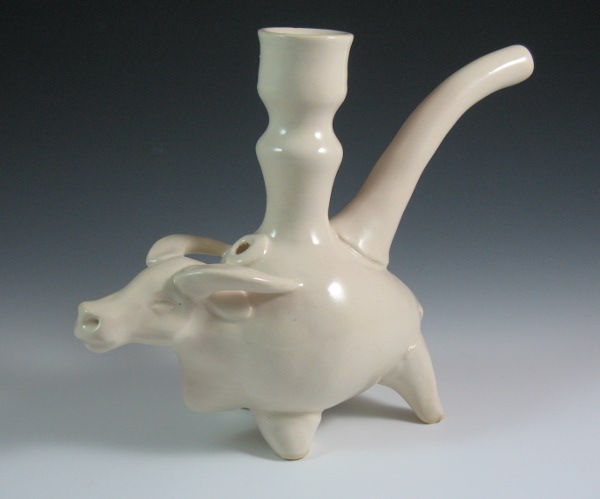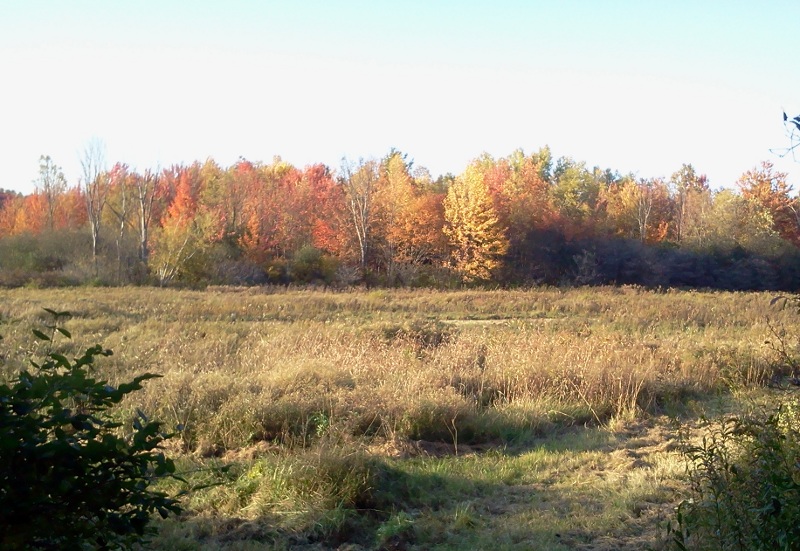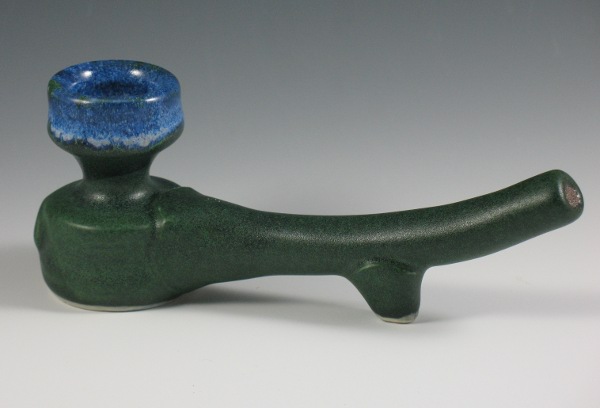I’ve been away from home and studio for much of the holiday season, but I’m back and pleased by the latest firing in my new kiln. Among the new pipes are a few that I like particularly well. As always, clicking on the thumbnail will yield a larger and more detailed image.
As always, clicking on the thumbnail will yield a larger and more detailed image.
This little effigy hand pipe is in the form of a beluga whale, one of my favorite marine mammals. The glaze is my crystalline white, which flowed across the contours of the piece in a particularly lovely way. There is a quality to this piece that reminds me a bit of an ivory carving, though of course it’s porcelain, made from clay and other minerals mined from the earth. I suspect that after many years of use, the pipe may take on the faint yellow sheen of ancient ivory, from the combustion of the smoking mixture, and if so, the resemblance will seem even more notable. There is already a faint warm color along edges, caused by traces of iron in the porcelain.
of the smoking mixture, and if so, the resemblance will seem even more notable. There is already a faint warm color along edges, caused by traces of iron in the porcelain.
 I’ve also made a few more effigy pipes in the form of lizards, some with carbs and some without. One of my sale venues does not allow carbs or water pipes, so I have adapted these designs to that market, and the pipes work very well despite these restrictions.
I’ve also made a few more effigy pipes in the form of lizards, some with carbs and some without. One of my sale venues does not allow carbs or water pipes, so I have adapted these designs to that market, and the pipes work very well despite these restrictions.
 For example, to the left is a lizard effigy pipe with a red-brown glaze. This glaze is quite similar to the slip glazes used by early American stoneware potters to glaze the interior of crocks and jugs. I like to think of myself as an eclectic potter, using in many cases the forms inspired by pre-Columbian indigenous potters, and the materials of the great Chinese potters, who were my original and still powerful influences, and who also used these beautiful high-iron glazes.
For example, to the left is a lizard effigy pipe with a red-brown glaze. This glaze is quite similar to the slip glazes used by early American stoneware potters to glaze the interior of crocks and jugs. I like to think of myself as an eclectic potter, using in many cases the forms inspired by pre-Columbian indigenous potters, and the materials of the great Chinese potters, who were my original and still powerful influences, and who also used these beautiful high-iron glazes.
One of the more interesting directions I’ve pursued lately is a series of effigy pipes celebrating the fishy form. I’ve always been a fisherman, and of course,  here along the Gulf Coast, where our family has lived for many years, fish are an important part of the local food
here along the Gulf Coast, where our family has lived for many years, fish are an important part of the local food  chain. I’ve caught a lot of fish, and eaten a lot of fish, and I’m still amazed by the beauty and color of these animals. My pipes are very simple representations, designed to in some way evoke fish as a primitive artist might attempt to create them. Both of these pipes are glazed in a limpid clear celadon that collects in texture to make a deeper color. The pipe of the right is a simple hand pipe of thrown and assembled parts, enhanced by carving. The pipe on the left is a platform pipe, made in tribute to the great platform pipes (in stone and clay) made by mound-building cultures in North America. Both pipes have carbs.
chain. I’ve caught a lot of fish, and eaten a lot of fish, and I’m still amazed by the beauty and color of these animals. My pipes are very simple representations, designed to in some way evoke fish as a primitive artist might attempt to create them. Both of these pipes are glazed in a limpid clear celadon that collects in texture to make a deeper color. The pipe of the right is a simple hand pipe of thrown and assembled parts, enhanced by carving. The pipe on the left is a platform pipe, made in tribute to the great platform pipes (in stone and clay) made by mound-building cultures in North America. Both pipes have carbs.
I also did a small series of baby bird effigy pipes. I really like this particular form.
There’s something very heartening about the idea that those who come to own these pipes will perhaps treat them as something more than clay and glaze, more than utilitarian objects. My hope is that these pieces will become heirlooms and be passed down the generations, that some day it won’t be weird to inherit your grandmother’s pipe.
I make these pipes with the hope that people will see them as beautiful objects in their own right. Pipes are all too often seen as purely utilitarian, to be used and discarded. And because these objects are high-fired porcelain, even if they are discarded, they are pretty much impervious to time.
I like to imagine archaeologists a thousand years from now digging up an ancient landfill and discovering these pipes, perhaps to their great puzzlement.
[contact-form][contact-field label=’Name’ type=’name’ required=’1’/][contact-field label=’Email’ type=’email’ required=’1’/][contact-field label=’Website’ type=’url’/][contact-field label=’Comment’ type=’textarea’ required=’1’/][/contact-form]




































